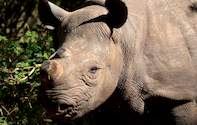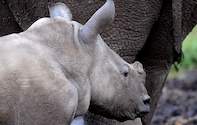
Learn more about rhino horn and the dehorning of rhino in this FAQ on rhino horn.
What is rhino horn made of?
A CT san has shown that rhino is similar in structure to horses hooves, cockatoo bills and turtle beaks and are made up of calcium, melanin and keratin.
What are rhino horn used for in the east?
- Yambiya handles in Yemen (coming of age status symbol)
- An alleged cure for cancer
- An aphrodisiac
- An alleged remedy against rheumatism, gout, fever, and other illnesses.
- Ornamental uses
Can rhino horn be sold on the international market?
Signatories to the Convention on the International Trade in Endangered Species (Cites) banned the trade in rhino horn in 1976. The Chinese government banned the use of rhino horn, or any other parts from endangered species, in Traditional Chinese Medicine, in 1993.
Can rhino horn be sold in South Africa?
The Minister of Environmental Affairs and Tourism published a moratorium on the trade of rhino horn and any derivatives or product of the horn within the country on 13 February 2009, in terms of Section 57(2) of the National Environmental Management: Biodiversity Act, 10 of 2004 (NEMBA). Rhino horn may be traded as part of a trophy obtained during a legal trophy hunt.

Does dehorning rhino have any legal implications?
In terms of the Threatened or Protected Species Regulations of 2007 (TOPS) drafted in terms of NEMBA no persons may, without being in possession of a valid permit: hunt, capture, kill, convey, import, export, keep live rhino in captivity, or possess a rhino horn.
Does dehorning deter poachers?
Poachers are prepared to remove any part of the horn, even the stump that is left after dehorning. Therefore, dehorning on its own is not enough. It will only reduce the temptation to potential poachers if the re-growth is cut regularly to ensure the horn mass remains very low. Zimambwe reported that their dehorning campaign was only successful if used in conjunction with traditional counter- and anti-poching measures such as regular patrols and population monitoring.
Can dehorning be achieved without injuring the horn?
A rhino's horn is not fixed to the skull, but is almost an extension of the skin and is similar to a person's fingernails. Cutting too close to the skull can cause injury to the animal and cause infection, even death.
Can dehorning affect the social behavior of rhinos?
According to the Zimbabwean authorities, who did an extensive dehorning exercise in the past, they could not detect any negative effect on the social behaviour of the dehorned rhinos. However, more research is needed on this issue.
Does rhino horn grow after dehorning?
Studies have shown that rhino horns grow at a rate of up to 12cm a year, but only if the plate of the horn is not damaged.
What happens with the horn after the dehorning?
A valid permit is required to possess the horn. It must be weighed, measured, micro-chipped and registered by a conservation official.
Will eco-tourists value the sighting of dehorned rhino?
This has not been investigated scientifically. However, it has been proposed that, should the reasoning behind the removal of the horns be explained, it may be possible that that the activity could be regarded as a protective action, and thus more positive.
Is dehorning costly?
Costs associated with dehorning include the veterinary costs (time and drugs), labour and possible air support. Depending on the circumstances, a dehorning can cost anything from R8 000 an animal, but will be proportionally reduced if more animals are dehorned during the same operation.

